Questions and answers on Macalester’s new fall plan
New “Mac Stays Safer” signs with social distancing guidelines are posted around campus in preparation for some students to arrive this fall. Photo by Estelle Timar-Wilcox ’22.
August 18, 2020
Over the last week, Macalester has upended its reopening plan for the fall semester. President Suzanne Rivera first announced that move in an Aug. 10 email to the campus community. On Wednesday, Aug. 12, Rivera held two webinar question-and-answer sessions on the fall plan, one for students and families and the other for faculty and staff.
With less than three weeks to go until the start of the fall semester, the webinar audiences had a number of questions about how the next few months at Macalester are going to look. The Mac Weekly assembled the following review of the major changes announced in the last week, and how those changes will affect the Macalester community this fall.
Will students still have work-study?
Admissions and Financial Aid announced the new Macalester Student Unemployment Insurance Program (MSUIP) — which is being offered to students who can’t get a work-study position. The insurance will replace up to 50 percent of the amount that students would have been able to earn.
This form will be available around September 5 to students who have already gone through the standard hiring and job search process and have been unable to find a job.
Assistant Vice President for Admissions and Financial Aid Brian Lindeman ’89 said that there likely will not be enough positions for everyone who has work-study as part of their financial aid package. So far, an unusually high number of new students have not been placed in work-study positions, and many returning students have had their usual positions cancelled.
During the Aug. 12 student and family webinar Rivera said Macalester is also hoping to offer remote job opportunities for students who rely on work-study but cannot return to campus in-person.
Lindeman encouraged students who find themselves in difficult financial situations to apply for aid through the Emergency Aid Program. Since its implementation last spring, he said, the program has seen around 200 applications. The financial aid office doesn’t fulfill the full amount of each request, but Lindeman said the office attempts to help where it can.
“We try to help the student with the best resource… or a resource that they didn’t know about,” Lindeman said. “I think our batting average has been pretty good in solving those needs.”
Would Macalester consider asking students to leave campus mid-semester?
Last March, as COVID-19 began to spread in Minnesota, students were sent home from campus with only a few days of warning. Rivera said in the webinar that she hopes to avoid a similar situation this fall.
She said that the college will first consider shifting to fully remote learning while still allowing students to remain in the residence halls.
“There’s a difference of going entirely remote for instruction and sending people home from campus,” Rivera said. “It is possible to do remote instruction while people are still living in residence halls.”
But sending students home is not out of the question.
Several factors will play into any decision about scaling back in-person learning and campus living. Rivera said that the college will be monitoring infection rates on campus and in Minnesota, including any government instructions.
“The situation here is very fluid, and we’re doing our best to respond to circumstances as they evolve,” she said.
What services will be available through the Laurie Hamre Center for Health and Wellness?
One shift announced in Rivera’s email was Macalester’s new plan to conduct two rounds of mandatory, free testing for all students living on-campus at the beginning of the fall semester. Students will be tested when they first arrive on campus and again in the following weeks before the quiet period ends.
Testing will also be required for students in off-campus housing.
The college’s earlier reopening plan didn’t include any asymptomatic testing because of scarcity of testing supplies and the Minnesota Department of Health has asked Macalester and institutions across the state not to test asymptomatic individuals.
The college was able to find a testing vendor that is not based in Minnesota, making it possible to test asymptomatic students without depleting the state’s resources.
“We felt it was ethical and appropriate for us to move forward with two rounds of screening tests, as opposed to diagnostic tests available for people,” Rivera said.
Medical Director and head of the Macalester Infectious Disease Task Force Dr. Steph Walters noted that asymptomatic testing doesn’t minimize the need for further precautions.
“It is important to remember that a negative test isn’t a ‘golden ticket’ —it simply means that on that day, they tested negative,” Walters wrote in an email to The Mac Weekly. “We need to stay vigilant throughout the semester.”
Testing in the Hamre Center for Health and Wellness for symptomatic students will come with a charge — much like any other lab test conducted on campus — but under the Coronavirus Aid, Relief, and Economic Security (CARES) act, all insurance companies must cover testing.
Rivera said that counseling will continue to be available to students remotely via telehealth services. Macalester’s Press 2 phone counseling service is also still available.
Where does the pandemic leave the college’s tuition and financial situation?
During her webinar on Tuesday, Rivera said that the college will likely run a deficit this semester. Macalester is not opting for a tuition reduction, unlike a few of institutions including Georgetown University, Princeton University and Lafayette College.
Instead, Rivera said, module five has been added on during summer 2021 at no extra charge to students who complete all of the previous modules.
Rivera also confirmed that students studying remotely will not pay for room and board.
Macalester Vice President of Administration and Finance David Wheaton hosted a webinar with faculty and staff on Aug. 6 in which he discussed the current and future state of the college’s finances.
He explained that Macalester is expecting to run a $5.5 million deficit this year, citing tuition shortfall and reduction in the number of students on campus. Student need in the coming year is higher than usual — financial aid is discounting 62 percent of tuition in total, up nearly ten percent from last year.
Wheaton suggested several methods that Macalester can use to recoup such costs, including selling bonds and making use of unrestricted reserves, a pool of surplus money from previous years’ operating costs. However, Wheaton noted that the cost estimates are based on the number of students enrolled, which can’t be certain until the first day of classes.
What will on-campus housing look like this fall?
The new fall reopening plan allows only first-years, transfer students and international students to return to campus housing and attend classes during module one.
“We were originally looking at that hinge point [between modules] as a possible place during which, if we had to switch to remote learning or even had to send people home, that it would give us space without disrupting our courses in the semester,” Rivera said.
Instead, Rivera said, the new plan marks a shift to a “ramping-up” strategy — the college hopes to welcome more students back to campus between modules.
Housing contracts of students in specialty housing, as well as sophomores and upperclassmen on campus and in the Drury Plaza Hotel, have been voided for module one. The hotel will not be used for module one, but the college may revisit that plan if conditions make it possible to welcome more students back to campus during module two.
Students that no longer have contracts have been notified individually about their housing, and can file need-based waivers to residential life for returning to campus.
Rivera also announced in the webinar that students who choose to travel for Thanksgiving will be asked not to return to campus for the remainder of the semester.
“We don’t want a bunch of people traveling home and coming back to campus that week, potentially creating an outbreak situation,” Rivera said.
Assistant Dean of Residential Life Coco Du said that the college is implementing this “de-densifying” of campus housing with the hope of limiting the spread of the virus. Under the old plan, many students in larger rooms would still have roommates; this shift allows for all students returning to campus to have single rooms.
Du said that Residential Life has been working to implement a housing setup that will encourage social distancing. Furniture in lounges and common areas will be rearranged and signs around campus will outline rules for distancing in specific spaces.
When students are tested for COVID-19, they will need to quarantine until their results come back. Quarantined students can stay in their rooms and will be assigned a specific quarantine restroom.
If a student living on campus tests positive, they will be moved to separate isolation areas with access to a private bathroom and meal delivery.
How does this plan change campus life?
Macalester’s new reopening plan calls for a two-week quiet period, during which no in-person classes will be held. Students living off campus will only have access to a few designated areas, including the Chapel, the food pantry and Cafe Mac.
“The quiet period is really an opportunity for us to keep the campus as free as possible with any contact with outside people and to reduce… large gatherings on campus,” Rivera said.
Students living in the residence halls will be able to use Café Mac and the rest of campus as long as they follow Macalester’s campus commitment, including wearing a mask in indoor spaces, following social distancing guidelines and using the app provided by the college to do a daily health check. Rivera said students would also be encouraged to eat outside when the weather allows for it.
Once the quiet period ends, students living off campus will be able to access campus spaces as long as they follow health regulations.
Even after the quiet period, however, student organizations will not be allowed to meet in person.
During the rest of module one, other areas around campus will likely be restricted or rearranged to adhere to social distancing. For example, the Leonard Center will be open only to student athletes. In exchange, some workout equipment will be placed in residence halls or the Campus Center for other students to use.
Rivera also said that Facilities Services has adjusted the HVAC system to ensure increased circulation in buildings.
How is Macalester preparing to shift academics and community to remote platforms?
In her webinar, Rivera emphasized that the online learning experience this fall will be significantly different from the one of the second half of the 2020 spring semester.
Faculty have now had more time to prepare for online learning, Rivera said. The college has also provided professors with new technology kits including high-quality cameras, tripods and iPads.
Rivera also outlined several remote community-building initiatives that the college is implementing in the fall. A new voluntary program called Mac Homeroom will meet four times over the course of the semester, encouraging students to connect with each other.
Orientation and Program Board events, such as Bingo for Books and the first-year talent show, will also be adapted to online platforms.














